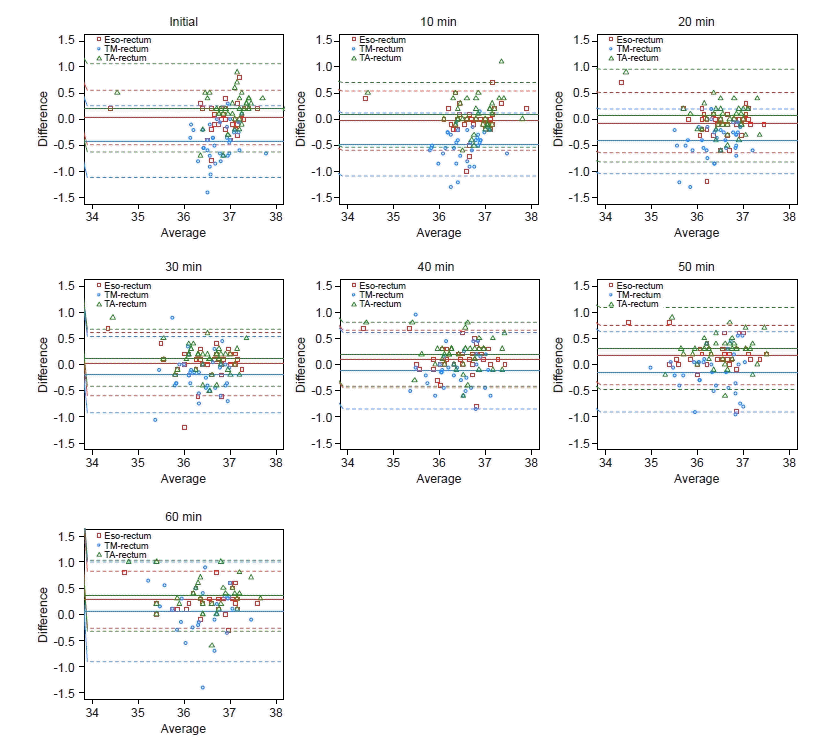1. Pearce B, Christensen R, Voepel-Lewis T. Perioperative hypothermia in the pediatric population: prevalence, risk factors, and outcomes. J Anesth Clin Res. 2010; 1:1–4.

2. Plattner O, Semsroth M, Sessler DI, Papousek A, Klasen C, Wagner O. Lack of nonshivering thermogenesis in infants anesthetized with fentanyl and propofol. Anesthesiology. 1997; 86:772–7.

3. Martin SA, Kline AM. Can there be a standard for temperature measurement in the pediatric intensive care unit? AACN Clin Issues. 2004; 15:254–66.

4. Kimberger O, Cohen D, Illievich U, Lenhardt R. Temporal artery versus bladder thermometry during perioperative and intensive care unit monitoring. Anesth Analg. 2007; 105:1042–7.

5. Hebbar K, Fortenberry JD, Rogers K, Merritt R, Easley K. Comparison of temporal artery thermometer to standard temperature measurements in pediatric intensive care unit patients. Pediatr Crit Care Med. 2005; 6:557–61.

6. Cook T, Howes B. Supraglottic airway devices: recent advances. Cont Educ Anaesthesia, Critical Care & Pain. 2011; 11:56–61.
7. Ahn JH, Park J, Ryu kH, Jo JS, Kang RA, Ko JS, et al. Utility of ultrasound evaluation of I‐Gel
® placement in children: An observational study. Paediatr Anaesth. 2021; 31:902–10.

8. Teunissen LPJ, Klewer J, De Haan A, De Koning JJ, Daanen HAM. Non-invasive continuous core temperature measurement by zero heat flux. Physiol Meas. 2011; 32:559–70.

9. Bouvet L, Albert ML, Augris C, Boselli E, Ecochard R, Rabilloud M, et al. Real-time detection of gastric insufflation related to facemask pressure–controlled ventilation using ultrasonography of the antrum and epigastric auscultation in nonparalyzed patients: a prospective, randomized, double-blind study. Anesthesiology. 2014; 120:326–34.
10. Park JH, Kim JY, Lee JM, Kim YH, Jeong HW, Kil HK. Manual vs. pressure‐controlled facemask ventilation for anaesthetic induction in paralysed children: a randomised controlled trial. Acta Anaesthesiol Scand. 2016; 60:1075–83.

11. Cubillos J, Tse C, Chan VWS, Perlas A. Bedside ultrasound assessment of gastric content: an observational study Evaluation échographique du contenu gastrique au chevet du patient: une étude observationnelle. Can J Anaesth. 2012; 59:416–23.
12. Lawson L, Bridges EJ, Ballou I, Eraker R, Greco S, Shively J, et al. Accuracy and precision of noninvasive temperature measurement in adult intensive care patients. Am J Crit Care. 2007; 16:485–96.

13. Bland JM, Altman DG. Agreement between methods of measurement with multiple observations per individual. J Biopharm Stat. 2007; 17:571–82.

14. Koo TK, Li MY. A guideline of selecting and reporting intraclass correlation coefficients for reliability research. J Chiropr Med. 2016; 15:155–63.

15. Sessler DI. Perioperative temperature monitoring. Anesthesiology. 2021; 134:111–8.

16. Hopf HW. Perioperative temperature management: time for a new standard of care? Anesthesiology. 2015; 122:229–30.
17. Cote CJ, Lerman J, Todres ID. A practice of anesthesia for infants and children: expert consult. Philadelphia: Elsevier Health Sciences;2012.
18. Bijur PE, Shah PD, Esses D. Temperature measurement in the adult emergency department: oral, tympanic membrane and temporal artery temperatures versus rectal temperature. Emerg Med J. 2016; 33:843–7.

19. Imamura M, Matsukawa T, Ozaki M, Sessler D, Nishiyama T, Kumazawa T. The accuracy and precision of four infrared aural canal thermometers during cardiac surgery. Acta Anaesthesiol Scand. 1998; 42:1222–6.

20. Langham GE, Maheshwari A, Contrera K, You J, Mascha E, Sessler DI. Noninvasive temperature monitoring in postanesthesia care units. Anesthesiology. 2009; 111:90–6.

21. Lopez‐Gil M, Brimacombe J, Alvarez M. Safety and efficacy of the laryngeal mask airway A prospective survey of 1400 children. Anaesthesia. 1996; 51:969–72.

22. Whitby JD, Dunkin LJ. Temperature differences in the oesophagus. The effects of intubation and ventilation. Br J Anaesth. 1969; 41:615–8.

23. Bissonnette B, Sessler DI, LaFlamme P. Intraoperative temperature monitoring sites in infants and children and the effect of inspired gas warming on esophageal temperature. Anesth Analg. 1989; 69:192–6.
24. Wadhwa A, Sessler DI, Sengupta P, Hanni K, Akça O. Core temperature measurements through a new airway device, perilaryngeal airway (CobraPLA). J Clin Anesth. 2005; 17:358–62.
25. Devitt JH, Wenstone R, Noel AG, O'Donnell MP. The laryngeal mask airway and positive-pressure ventilation. Anesthesiology. 1994; 80:550–5.
26. Litman RS. Complications of laryngeal masks in children: big data comes to pediatric anesthesia. Anesthesiology. 2013; 119:1239–40.
27. Graziotti PJ. Intermittent positive pressure ventilation through a laryngeal mask airway: is a nasogastric tube useful? Anaesthesia. 1992; 47:1088–90.
28. Mirzakhani H, Williams JN, Mello J, Joseph S, Meyer MJ, Waak K, et al. Muscle weakness predicts pharyngeal dysfunction and symptomatic aspiration in long-term ventilated patients. Anesthesiology. 2013; 119:389–97.
29. Lerman J. Surgical and patient factors involved in postoperative nausea and vomiting. Br J Anaesth. 1992; 69(7 Suppl 1):24S–32.

30. Lee J, Lim H, Son KG, Ko S. Optimal nasopharyngeal temperature probe placement. Anesth Analg. 2014; 119:875–9.

31. Hong SH, Lee J, Jung JY, Shim JW, Jung HS. Simple calculation of the optimal insertion depth of esophageal temperature probes in children. J Clin Monit Comput. 2020; 34:353–9.

32. Robinson JL, Seal RF, Spady DW, Joffres MR. Comparison of esophageal, rectal, axillary, bladder, tympanic, and pulmonary artery temperatures in children. J Pediatr. 1998; 133:553–6.







 PDF
PDF Citation
Citation Print
Print




 XML Download
XML Download